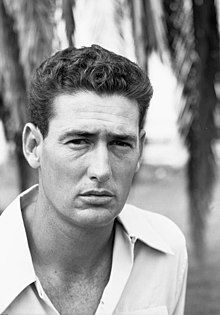On-base percentage
This article needs additional citations for verification. (July 2013) (Learn how and when to remove this template message) |
In baseball statistics, on-base percentage (OBP), also known as on-base average/OBA, measures how frequently a batter reaches base.[1] It is the ratio of the batter's times-on-base (TOB) (the sum of hits, walks, and times hit by pitch) to their number of plate appearances.[1] OBP does not credit the batter for reaching base due to fielding error, fielder's choice, dropped/uncaught third strike, fielder's obstruction, or catcher's interference.
An official MLB statistic since 1984, it is sometimes referred to as on-base average/OBA, as it is rarely presented as a true percentage.
On-base percentage is added to slugging average to determine on-base plus slugging (OPS). The on-base percentage of all batters faced by one pitcher or team is referred to as on-base against.
Overview[edit]
Traditionally, players with the best on-base percentages bat as leadoff hitter, unless they are power hitters, who traditionally bat slightly lower in the batting order. The league average for on-base percentage in Major League Baseball has varied considerably over time; at its peak in the late 1990s, it was around .340, whereas it was typically .300 during the dead-ball era. On-base percentage can also vary quite considerably from player to player. The highest career OBP of a batter with more than 3,000 plate appearances is .482 by Ted Williams. The lowest is by Bill Bergen, who had an OBP of .194.
On-base percentage is calculated using this formula[2][3][4]:
where
- H = Hits
- BB = Bases on Balls (Walks)
- HBP = Hit By Pitch
- AB = At bat
- SF = Sacrifice fly
In certain unofficial calculations, the denominator is simplified and replaced by Plate Appearance (PA); however, the calculation PAs includes certain infrequent events that will slightly lower the calculated OBP (i.e. catcher's interference, and sacrifice bunts).[4] Sacrifice bunts are excluded from consideration on the basis that they are usually imposed by the manager with the expectation that the batter will not reach base, and thus do not accurately reflect the batter's ability to reach base when attempting to do so.[1]
All-time leaders[edit]
bold is active player
Single-season leaders[edit]
| # | Player | OBP[6] | Team | Year |
| 1 | Barry Bonds | .6094 | San Francisco Giants | 2004 |
| 2 | Barry Bonds | .5817 | San Francisco Giants | 2002 |
| 3 | Ted Williams | .5528 | Boston Red Sox | 1941 |
| 4 | John McGraw | .5475 | Baltimore Orioles | 1899 |
| 5 | Babe Ruth | .5445 | New York Yankees | 1923 |
| 6 | Babe Ruth | .5319 | New York Yankees | 1920 |
| 7 | Barry Bonds | .5291 | San Francisco Giants | 2003 |
| 8 | Ted Williams | .5256 | Boston Red Sox | 1957 |
| 9 | Billy Hamilton | .5209 | Philadelphia Phillies | 1894 |
| 10 | Babe Ruth | .5156 | New York Yankees | 1926 |
See also[edit]
Notes[edit]
- ^ a b c "Glossary / Standard Stats / On-base Percentage (OBP)". MLB.com. Retrieved 13 June 2018.
- ^ [https://www.baseball-reference.com/leaders/onbase_perc_career.shtml Baseball reference: OBP
- ^ Beyond the Box Score
- ^ a b Fangraphs
- ^ "Career Leaders for On Base Percentage". Sports Reference, Inc. Retrieved 2011-06-25.
- ^ "Single Season League Leaders for On-Base Percentage". Sports Reference, Inc. Retrieved 2011-06-25.


No comments:
Post a Comment